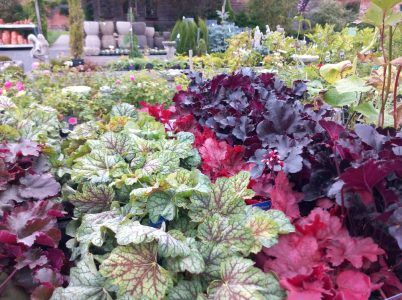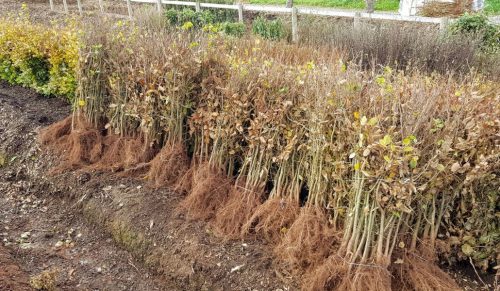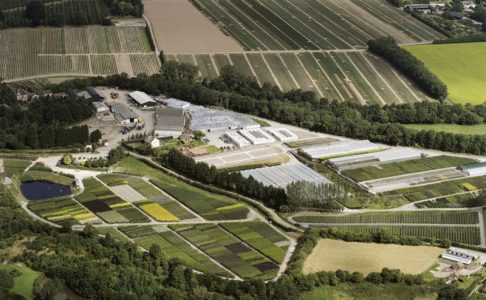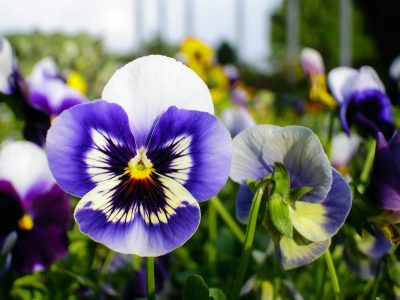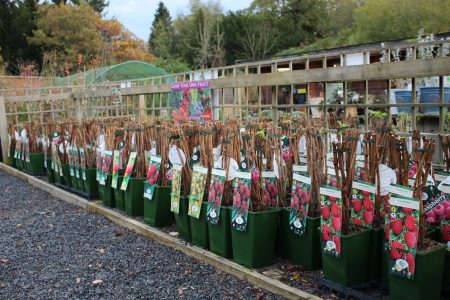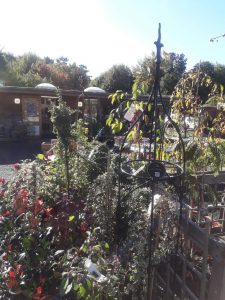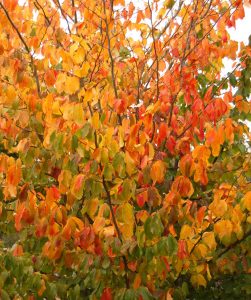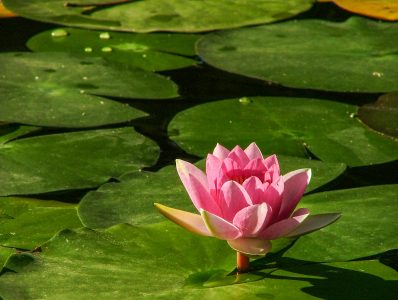Hints and Tips
Gardening Tasks for September
The wonderful summer weather has been a joy to us all, but also a challenge for gardeners as our plants begin to flag in the absence of significant rainfall. This has really emphasised the need for feeding and mulching, in order to keep plants strong and healthy during stressful dry periods, and to trap as much moisture in the soil as possible. This is something to remember as we edge towards autumn and winter as mulching is just one of the gardening tasks for September.
New Planting Season
September is a very busy month in the garden, and marks the start of a new season of planning, tidying up and planting for autumn interest. Perennial plants such as heathers and heucheras put on a good display in the later part of the year and, supplemented with bedding plants like violas and pansies, will make a colourful splash in the autumn and right through to the spring. Bedding cyclamen are also looking good at this time of year, but bear in mind that these are not hardy in the Scottish Borders, and will die off when the first frosts arrive.
Plant up Winter Pots
Now is a good time to plant up autumn and winter pots. Dwarf conifers are a good option as a centre-piece in pots as these come in a variety of leaf forms and shades ranging from blue-grey to deep green and are very hardy. Remember to use fresh compost as the old compost will have had nutrient depletion throughout the summer. Make sure that drainage holes in the pots are open by raising them on pot feet and putting crocks or stones in the bottom of the pot. At Woodside we recommend using Growmoor Multi-purpose Compost with Added John Innes – it’s the one we use for all our re-potting.
Care for Summer Bedding
Summer bedding plants in hanging baskets and pots will keep going until the first frosts. Hopefully you have been keeping up with watering and feeding them over the summer – if so, they will still be looking good. Remember to continue to feed them with a liquid feed and to keep dead-heading them. My pots and hanging baskets at home have never been better – they have really enjoyed the summer sun, and weekly feeding has ensured that there are always fresh flowers.
Refresh your Perennial Borders
Out in the garden, it’s a good time to assess whether you have enough late-flowering perennials to keep the garden looking good, and to provide a nectar source for pollinating insects into the autumn. Any gaps can be filled with Sedums, Echinacea and Rudbeckias which can all be planted at this time of year. Congested clumps of perennials, such as hardy Geraniums and Hemeracollis can be lifted, divided and replanted to keep them heathy and fresh.
Plant Spring Bulbs
September is a good month for planting spring flowering bulbs, such as crocuses, snowdrops, daffodils and fritillaries, both in the garden and underneath autumn bedding plants in pots. Why not try planting up an Allium border? These are members of the onion family and have striking rounded heads of flowers, usually in blues and purples and sometimes in white, which are loved by bees and other beneficial insects. The foliage can look very scruffy, so I’d always recommend to plant them amongst perennials which will hide the foliage but allow the flower spikes to emerge above them.
Vegetable Garden
In the kitchen garden you can still plant hardy greens, such as pak choi, kale, broccoli and spring cabbage – remember to protect against pigeon damage by using micromesh or netting.
Prune out all the fruited canes of summer raspberry canes by cutting them right to the base and tie in thenew canes to supports.
Plant fruit trees like apples, pears and plums while the ground is warm – making sure to water all new plantings in well.
Gardening Tasks for April
Spring is here and with it a flurry of activity in the garden. Start planning now to make the most of any Easter break you might have planned.
- Towards the end of the month sow hardy annual seeds such as Calendula into gaps in borders
- Plant out young plants of native wildflowers to provide food for insects and birds
- Plant Spring bedding plants such as Primulas, Polyanthus, Violas and Pansies in pots and at the front of borders to give a splash of colour
- Protect new shoots of Hostas, Delphiniums and other vulnerable plants from slugs and snails using slug pellets or Slug Gone
- Dead-head spring flowering bulbs and bedding plants to stop them wasting energy on seed production
- Harden off plants overwintered indoors, such as Cannas, remembering to keep an eye on the weather forecast to bring them back in when frost is forecast
- Spray the new leaves of roses with Fungus Clear to control mildew, blackspot and rust, and spray for aphids if needed
- Prune Hydrangeas by cutting back the old flower stems to a string shoot
- Prune Buddleias to a healthy shoot
- Restart old and tired shrubs such as Potentillas, Spiraea and Berberis by cutting back hard to the base
- Lift and divide congested clumps of hardy perennials such as Asters, Hemeracollis and Hostas
- Plant out Lily Bulbs and Dahlia tubers
- Start planting water plants in garden ponds and water features
- Split and replant overgrown water plants
- Push in a fertiliser tablet to aquatic planters to give them a good feed
- Add barley straw pouches to ponds to help prevent the build up of blanketweed
- Switch water pumps back on after cleaning all filters
- Prepare the vegetable garden ready for planting
- Plant out hardened off leeks and onion plants
- Plant Second Early and Maincrop potatoes in trenches in the veg garden or in pots or potato bags
- Plant out brassicas remembering to place cabbage collars around the stems to deter cabbage root flies
- Sow seeds of courgettes and cucumbers indoors ready for planting out when the risk of frost has passed
- Start off seeds of Broad Beans, French beans and Runner beans indoors
- Sow small batches of rocket, radishes and salad leaves outdoors, and coriander and basil indoors
- Plant out fresh strawberry plants and hardy herbs
- Continue sowing and pricking out of bedding plants and perennials
- Sow sweet peas in deep pots or Root-trainers in a greenhouse or sunny windowsill
- Plant tomato plants into growbags or Wool Tomato Compost in a heated greenhouse or polytunnel
- Don’t forget to open greenhouse doors and vents on sunny days to aid ventilation
- Repair damaged lawn patches with turf or lawn seed
- Remove moss and weeds from turf and boost grass growth with a lawn feed
- Cut back old and tatty fern fronds to make way for fresh unfurling shoots
- Keep watching the weather forecast and have rolls of fleece handy for protection against frosts
- Prune out unwanted suckers from trees and shrubs
- Hoe between rows of vegetable plants regularly to control weed growth
- Spray off more troublesome weeds and remember to respray as they regrow
- Keep an eye out for aphids on new shoots of emerging plants and spray as required with pesticide or soapy water
- Weed, feed and mulch any borders and beds not yet done
Continue feeding birds as they are now busy raising their young
Bare-Rooted Hedging
Buying bare-rooted hedging plants (that is without compost or pots) is much more cost effective than buying them as potted plants. While container grown plants are available all year round, bare-rooted plants are only available during the dormant season, usually November to February, when they are lifted from the ground with the minimum amount of disturbance to them. Once received plants should be planted as soon as possible to prevent the exposed roots from drying out, or if that’s not possible they can be heeled in to a spare patch of ground ready to be transplanted into their permanent position at a later date.
Some evergreen hedging plants such as hollies and Leylandii are best purchased as potted plants, as they can dry out very quickly without the protection of compost, and so are unlikely to plant out successfully. Deciduous plants suitable for planting as bare-rooted plants include hawthorn, sloes, beech, hazel, wild roses, and hornbeam. A good mix of plants can provide a thriving hedgerow habitat for wildlife fairly quickly after planting.
We do not carry bare-rooted stock at Woodside, so all of your hedging requirements need to be pre-ordered via this list and order form:
Please click here to download it.
How to Plant Bare-Rooted Hedging
In general, I would recommend that bare-rooted hedging plants are planted at a maximum of 3 per metre (about 1ft apart) for a single row. If you are looking for a thicker hedge, then a double staggered row is the way to plant them – this means you need 5 per metre.
To plant, you need to prepare the ground thoroughly; your hedge will be there for a long time and this will be your only opportunity to improve the soil. Clear the site of weeds, and dig over well, removing any weed roots. Use a garden line to dig out a straight trench about 25cm deep and add a good weed-free compost (either your own home-made compost or a bought bagged one such as Rose Tree and Shrub planting compost) and well-rotted manure, and fork into the base of the trench. Return the soil to the trench, adding a good handful per metre of Bonemeal or Growmore.
Separate your bundles of hedging into individual plants, and place in the trench, adding a sprinkle of Rootgow to the base of each plant. Firm down the soil well around the plants, and water them in. You also need to be prepared to water them regularly for the first year during dry spells, just until the roots get established.
If you need any advice on hedging plant selection, just give us a phone on 01835 830315, or visit Woodside and have a chat to us. Any problems opening the link just let me know and I can email you directly, or pick up a paper copy from the plant shop.
Bareroot hedging
Our bareroot hedging price list for winter 2023/24 is now ready!
I know it seems a bit early to be thinking about winter planting, but it’s always good to plan ahead, and we’ve already had quite a lot of people asking about bare root hedging plants. These are plants that are supplied without pots or compost over the dormant season – usually November to March, and it’s the cheapest way to purchase hedging plants.
You can see our price list and order form by clicking HERE or come into the plant shop and collect a paper copy. We are happy to take orders over the phone, in person or via email.
Please note that payment is required with your order, as we order these in specially for you, and that plants will be available from November 2023 – February 2024. We will contact you when your order is ready for collection.
For a really useful guide to hedging plants, and how to plant them, you might enjoy this RHS article
For any other queries please call us on 01835 830315.
Autumn Tree Planting
With darker evenings and farmers busy harvesting, our thoughts are turning to autumn tree planting. Autumn is fast approaching, it is my favourite time of year and a busy one for gardeners.
The late summer and autumn are the perfect seasons for getting trees established. Here at Woodside we bring on some of our own trees from British sourced stock and also work in partnership with Frank P Matthews tree nursery – a multi-award winning nursery which supplies top quality container grown trees to many UK planting projects. As you can see from the photo, this is a huge operation consisting of propagation greenhouses and polytunnels, nursery beds and fields and fields of trees. The lake you can see to the left of the photograph is their reservoir for all that watering.
Autumn Tree Planting Tips
We are now taking advance orders for autumn trees and if you click HERE you will open our list of container grown fruit and ornamental trees that are available this autumn. I’ve indicated rootstocks when appropriate for fruit trees, and pot sizes for the ornamentals, as well as the price. Some of the items are available just now, and the rest will be due in late August/September. If you would like to order a tree from the list please call 01835 830315 and have your card handy to make a payment. Alternatively email me emma@woodsidegarden.co.uk with your order and leave your phone number so we can call you back for payment. We’ll then phone as soon as the trees are available for you to collect, or we can arrange delivery.
Don’t forget to:
- stake and tie to secure your trees against wind damage
- feed trees with bonemeal
- help the roots establish with Rootgrow
- use planting compost for sites with poor soils
- use tree guards if you are plagued by rabbits and hares.
Autumn and Winter Bedding
Autumn and winter bedding plants will be arriving at Woodside soon, along with our biggest range of bulbs yet – lsign up to our newsletter to receive the latest updates.
Gardening In August
Whilst most of you have been enjoying your garden in the sunshine over the last week or so, we have been planning our stock for the rest of the year. In the gardening business we always seem to looking at least three months ahead, which is why I am busy placing Christmas orders. (Sorry!)
Many gardeners will also be thinking about what they would like to improve for next year and will be planning for colour throughout the year. Here are a few things you can do in your garden now and over the next few weeks to increase the enjoyment of your garden.
- Plant potatoes ready for Christmas – we have in stock both Charlotte and Pentland Javelin seed potatoes which can be planted now for you to harvest home-grown new potatoes on christmas morning.
- Sow autumn and winter bedding plant seeds such as pansies, wallflowers and sweet williams – seeds available in the plant centre
- Sow green manure seeds to improve the fertility of the soil
- Plant some conifers – we have a new delivery of conifers from specialist growers Golden Grove. These plants offer great value for money with year round interest
- Feed your garden – quite often when Stephen and I are answering questions to do with garden plants under-performing it seems that a lot of gardeners don’t realise that plants need regular feeding. With the weather set to break soon (maybe later today?) now is a great time to get some feed into the garden. It’s not difficult to do and usually involves scattering handfuls of granular fertiliser onto your borders, or watering fertiliser into pots and containers, so no heavy digging required! Feeding now will enable plants to build up strength and vigour before autumn and winter set in, which will in turn improve performance and growth next year. Our current range of fertilisers includes Growmore, Bonemeal, slow release granules, TopRose and more. Just ask for advice when you visit.
- Plant spring bulbs in autumn – these will be coming into stock in August and into September. Planting in autumn will ensure a riot of colour next spring.
Photo credit: Photo by mostafa meraji on Unsplash
How to Plant Raspberry Canes
With our raspberry canes now in stock, I thought I’d share a few tips on how to plant raspberry canes:
- Choose a well drained spot in full sun, weed the ground and construct post and wire fencing support for summer fruiting varieties (autumn varieties don’t need this), avoiding ground that has previously grown raspberries.
- The planting depth is important with raspberries and as a rule of thumb, aim for the old soil mark on the stem to be at the same level as the ground after planting. To do this, dig a shallow hole, about 30cm (1ft) wide and 8cm (3in) deep. Add a scattering of Rootgrow in the bottom of the hole to help root establishment.
- Spread out the roots and cover with soil, firming as you go.
- Plant canes 40cm (16in) apart.
- Cut canes down to 30cm (1ft) above the soil, pruning above a bud, and water well.
More Planting Trees available!
Some may be sad to see the end of Summer, but here at Woodside we are excited that Autumn has begun and that it is the start of Tree Planting season.
We have the best choice in the Scottish Borders for ornamental trees suitable for planting in this area.
So many to choose from, we have around:
-
14 varieties of Sorbus (Rowan & Whitebeam) to choose from including rare varieties such as: Ravensbill, Fingerprint, Bisetti Pearls, and Hemsleyi John Bond.
-
5 varieties of Liquidamber (Sweetgum Tree) which put on an exceptional show of autumn colour.
-
6 varieties of Malus (Crab Apple) which produce showy edible autumn fruits.
-
7 varieties of Betula (Silver Birch) including the aptly named variety “Edinburgh”.
We also have the stunning long needled Pinus Wallichiana, the rare oak Quercus Crimsonschmidt, beautiful Acer Rubrum October Glory, and the maple syrup tree – Acer Saccarinum.
All of which have good Autumn or Winter interest.
Please note – that some trees were ordered in as singles, meaning we only have 1 of that variety for sale. Once it’s gone, it’s gone. Interest in the trees this weekend is likely to be strong, so don’t delay your visit to pick out the tree you’re looking for.
Tree Planting for the Autumn Season
It is now tree planting season, and in stock we have a great choice of fresh trees available for the autumn season.
Grown in Yorkshire, the trees selected have been chosen for hardiness and autumn interest.
Highlights include:
Cercidiphyllum Japonica Pendula – The Weeping Katsura Tree, which has attractive heart shaped leaves which turn fiery shades of red and orange in the autumn. Originating in Japan, this ancient tree gives off an unmistakable smell of candyfloss in the autumn as the leaves begin to fall.
Liquidamber Palo Alto – This is a rare form of Liquidamber, rarely offered for sale in the UK, which has an upright habit, and leaves resembling a Japanese Maple. Liquidambers are well known for autumn leaf colour, and this one turns dark mottled red in the autumn.
Malus Rosehip – An attractive new form of crab apple which has masses of white blossom in the spring and forms beautiful rounded red fruits in the autumn, which strongly resemble rosehips in appearance. The fruits can be used for cooking, jam and jelly making, or left for the birds to enjoy.
Sorbus Joseph Rock – This is a yellow berried form of the native Rowan, or Mountain Ash, and is easy to grow and very hardy. A good plant for autumn berry colour in colder gardens.
Quercus Crimschmidt – This is a new Oak hybrid, sometimes called Crimson Spire, and it has a narrow habit with dark green leaves turning a stunning red in autumn.
Betula Jaquemontii – Probably the best of all the white stemmed birches, the Himalayan Birch is hardy and easy to grow, and is offered as a single or multi-stemmed tree.
Tree sales are likely to be brisk over the next few days, so if you would like us to reserve any of the trees listed please give us a call on 01835 830315. Better still, come in and see what trees we have, as there are many more varieties available.
How to Choose Plants for Your Pond
Here at Woodside we have decided to stock water plants, after so many customers have asked us to, so I thought I’d tell you a bit about water gardening and how to choose plants for your pond
Wildlife Habitat
Ponds make a wonderful addition to the garden – as well as creating extra habitats for wildlife, it also provides different planting conditions for a whole host of plants. The most successful ponds tend to have a boggy area next to them to allow moisture loving plants to grow there and to make a smooth transition from pond to garden. Not only that, but the sound of moving water is very relaxing, and the presence of fish in the pond gives an extra dimension to your enjoyment of your garden. Ponds are generally sited in sunny spots, which makes plant growth stronger, but also encourages algae growth.
Water Lilies
Ideally a pond should have 30-40% of its surface area covered with plant leaves, using plants such as Water Lilies, and other deep water marginals like the very pretty Water Hawthorn (Aponogeton) and the Yellow Fringed Lily, which isn’t strictly speaking a lily at all, but a close relative (Nymphoides Peltata). This will help shade the water from the sun and reduce algae growth. Water lilies prefer still water to moving water, so be sure to site them away from fountains and inlet streams, and read the label carefully to make sure they are at the right depth within the pond. Miniature Water Lilies can be submerged in large water-tight containers if you don’t have space for a pond.
Oxygenators
Oygenators and floating plants are vital for the health of the pond. Oxgenating plants grow and photosynthesise under water, releasing oxygen into the water which is essential for water dwelling animals as well as for keeping the water full of healthy bacteria to help keep it clean. Crystal Confetti (Hydrocotyl) is one of the most attractive oxygenators and should be submerged in the pond. Floating plants, such as Water Soldiers (Stratiotes) can simply be thrown into the pond, making them the easiest plant in gardening to actually plant! Barley straw products also help keep pond clear and they act as an algae inhibitor – the product we currently have in stock treats up to 2000 gallons and last approx. 6 months.
Height and Structure
A selection of tall, grass like plants are useful for height, structure and for allowing emerging larvae of dragonflies to hatch. Recommended varieties are Lesser Bulrush (Typha Angustifolia) and any of the water loving Irises. Other marginal plants provide colour and texture.
Bog Garden
By creating a bog garden you give yourself the opportunity to plant a whole range of plants from the beautiful green foliage of Hostas and Ferns to the bright colourful flowers of Candelabra Primroses.
We have a good selection of water plants available, so why not drop by if your are planning to create your own pond from scratch or re-stock your existing one.

